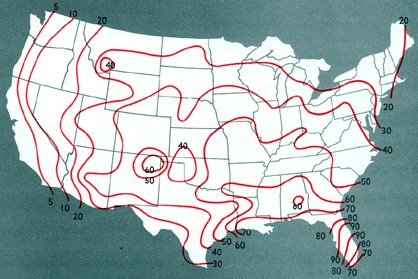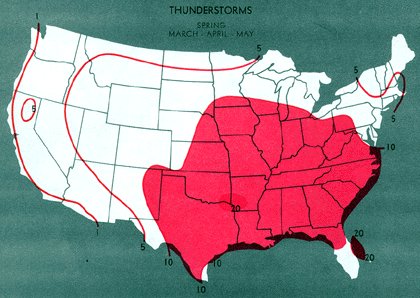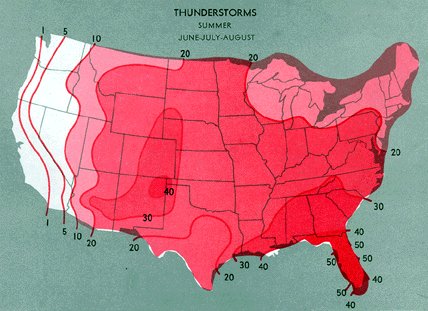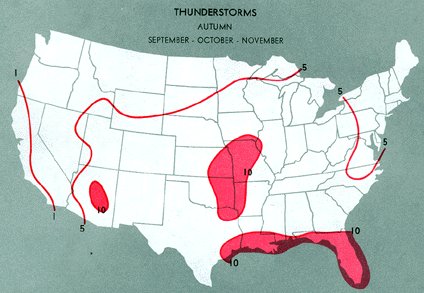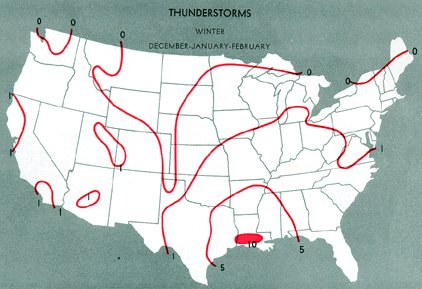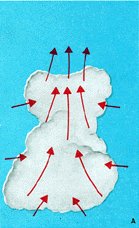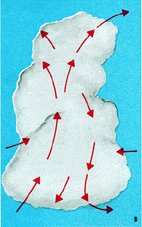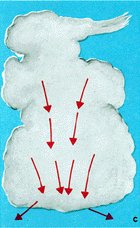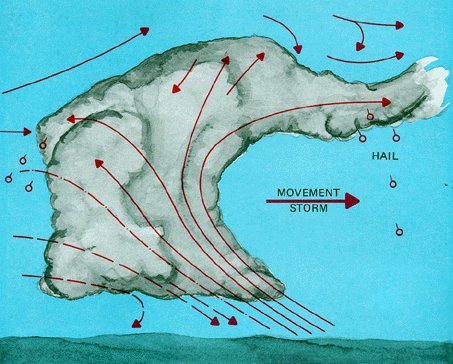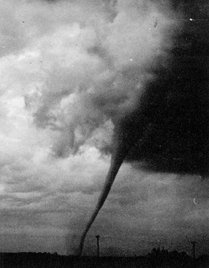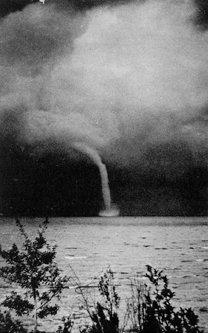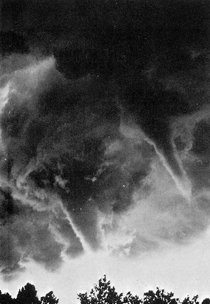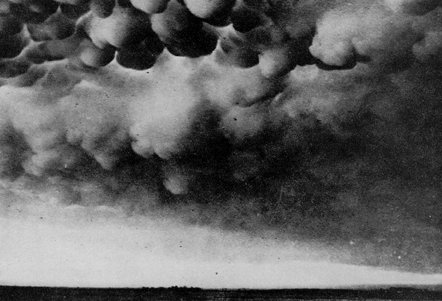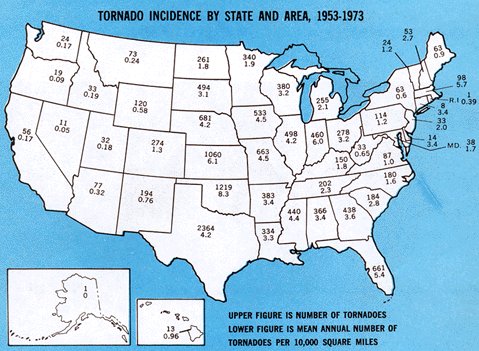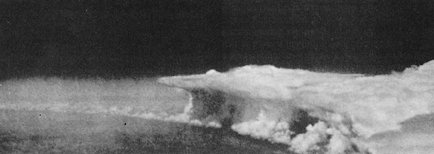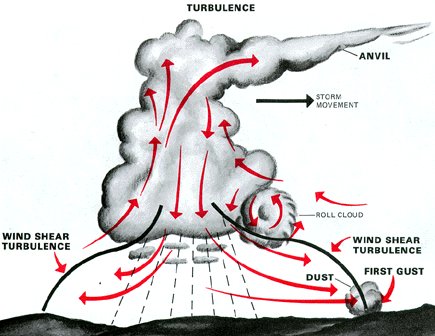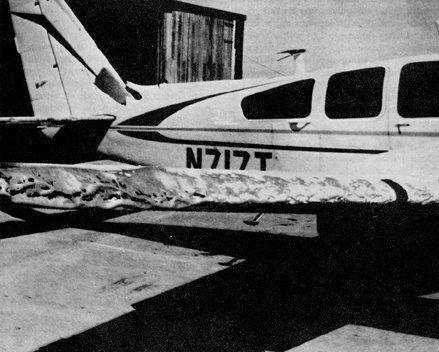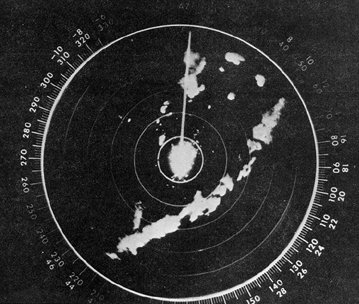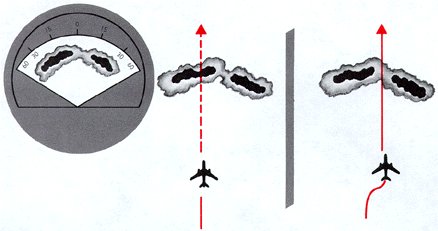|
For Pilots and Flight Operations Personnel PART I. WHAT YOU SHOULD KNOW ABOUT WEATHER
Many times you have to make decisions involving thunderstorms and flying. This chapter looks at where and when thunderstorms occur most frequently, explains what creates a storm, and looks inside the storm at what goes on and what it can do to an aircraft. The chapter also describes how you can use radar and suggests some do's and don'ts of thunderstorm flying.
Figure 100 shows the average number of thunderstorms each year in the adjoining 48 States. Note the frequent occurrences in the south-central and southeastern States. The number of days on which thunderstorms occur varies widely from season to season as shown in figures 101 through 104. In general, thunderstorms are most frequent during July and August and least frequent in December and January.
Thunderstorms have been a subject of considerable investigation for many years as they are today. Figuratively speaking, let's look inside a thunderstorm.
LIFE CYCLE A thunderstorm cell during its life cycle progresses through three stages - (1) the cumulus, (2) the mature, and (3) the dissipating. It is virtually impossible to visually detect the transition from one stage to another; the transition is subtle and by no means abrupt. Furthermore, a thunderstorm may be a cluster of cells in different stages of the life cycle. The Cumulus Stage Although most cumulus clouds do not grow into thunderstorms, every thunderstorm begins as a cumulus. The key feature of the cumulus stage is an updraft as illustrated in figure 105(A). The updraft varies in strength and extends from very near the surface to the cloud top. Growth rate of the cloud may exceed 3,000 feet per minute, so it is inadvisable to attempt to climb over rapidly building cumulus clouds.
The Mature Stage Precipitation beginning to fall from the cloud base is your signal that a downdraft has developed and a cell has entered the mature stage. Cold rain in the downdraft retards compressional heating, and the downdraft remains cooler than surrounding air. Therefore, its downward speed is accelerated and may exceed 2,500 feet per minute. The down rushing air spreads outward at the surface as shown in figure 105(B) producing strong, gusty surface winds, a sharp temperature drop, and a rapid rise in pressure. The surface wind surge is a "plow wind" and its leading edge is the "first gust."
The Dissipating Stage Downdrafts characterize the dissipating stage of the thunderstorm cell as shown in figure 105(C) and the storm dies rapidly. When rain has ended and downdrafts have abated, the dissipating stage is complete. When all cells of the thunderstorm have completed this stage, only harmless cloud remnants remain.
Individual thunderstorms measure from less than 5 miles to more than 30 miles in diameter. Cloud bases range from a few hundred feet in very moist climates to 10,000 feet or higher in drier regions. Tops generally range from 25,000 to 45,000 feet but occasionally extend above 65,000 feet.
AIR MASS THUNDERSTORMS Air mass thunderstorms most often result from surface heating. When the storm reaches the mature stage, rain falls through or immediately beside the updraft. Falling precipitation induces frictional drag, retards the updraft and reverses it to a downdraft. The storm is self-destructive. The downdraft and cool precipitation cool the lower portion of the storm and the underlying surface. Thus, it cuts off the inflow of water vapor; the storm runs out of energy and dies. A self-destructive cell usually has a life cycle of 20 minutes to 1 1/2 hours. Since air mass thunderstorms generally result from surface heating, they reach maximum intensity and frequency over land during middle and late afternoon. Off shore, they reach a maximum during late hours of darkness when land temperature is coolest and cool air flows off the land over the relatively warm water. STEADY STATE THUNDERSTORMS Steady state thunderstorms usually are associated with weather systems. Fronts, converging winds, and troughs aloft force upward motion spawning these storms which often form into squall lines. Afternoon heating intensifies them. In a steady state storm, precipitation falls outside the updraft as shown in figure 106 allowing the updraft to continue unabated. Thus, the mature stage updrafts become stronger and last much longer than in air mass storms - hence, the name, "steady state." A steady state cell may persist for several hours.
TORNADOES The most violent thunderstorms draw air into their cloud bases with great vigor. If the incoming air has any initial rotating motion, it often forms an extremely concentrated vortex from the surface well into the cloud. Meteorologists have estimated that wind in such a vortex can exceed 200 knots; pressure inside the vortex is quite low. The strong winds gather dust and debris, and the low pressure generates a funnel-shaped cloud extending downward from the cumulonimbus base. If the cloud does not reach the surface, it is a "funnel cloud," figure 109; if it touches a land surface, it is a "tornado," figure 107; if it touches water, it is a "water spout," figure 108.
An aircraft entering a tornado vortex is almost certain to suffer structural damage. Since the vortex extends well into the cloud, any pilot inadvertently caught on instruments in a severe thunderstorm could encounter a hidden vortex. Families of tornadoes have been observed as appendages of the main cloud extending several miles outward from the area of lightning and precipitation. Thus, any cloud connected to a severe thunderstorm carries a threat of violence. Frequently, cumulonimbus mamma clouds occur in connection with violent thunderstorms and tornadoes. The cloud displays rounded, irregular pockets or festoons from its base and is a signpost of violent turbulence. Figure 110 is a photograph of a cumulonimbus mamma cloud. Surface aviation reports specifically mention this and other especially hazardous clouds.
A squall line is a nonfrontal, narrow band of active thunderstorms. Often it develops ahead of a cold front in moist, unstable air, but it may develop in unstable air far removed from any front. The line may be too long to easily detour and too wide and severe to penetrate. It often contains severe steady-state thunderstorms and presents the single most intense weather hazard to aircraft. It usually forms rapidly, generally reaching maximum intensity during the late afternoon and the first few hours of darkness. Figure 112 is a photograph of an advancing squall line.
Hazardous turbulence is present in all thunderstorms; and in a severe thunderstorm, it can damage an airframe. Strongest turbulence within the cloud occurs with shear between updrafts and downdrafts. Outside the cloud, shear turbulence has been encountered several thousand feet above and 20 miles laterally from a severe storm. A low level turbulent area is the shear zone between the plow wind and surrounding air. Often, a "roll cloud" on the leading edge of a storm marks the eddies in this shear. The roll cloud is most prevalent with cold frontal or squall line thunderstorms and signifies an extremely turbulent zone. The first gust causes a rapid and sometimes drastic change in surface wind ahead of an approaching storm. Figure 113 shows a schematic cross section of a thunderstorm with areas outside the cloud where turbulence may be encountered.
ICING Updrafts in a thunderstorm support abundant liquid water; and when carried above the freezing level, the water becomes supercooled. When temperature in the upward current cools to about -15° C, much of the remaining water vapor sublimates as ice crystals; and above this level, the amount of supercooled water decreases. Supercooled water freezes on impact with an aircraft (see chapter 10). Clear icing can occur at any altitude above the freezing level; but at high levels, icing may be rime or mixed rime and clear. The abundance of supercooled water makes clear icing very rapid between 0° C and -15° C, and encounters can be frequent in a cluster of cells. Thunderstorm icing can be extremely hazardous. HAIL Hail competes with turbulence as the greatest thunderstorm hazard to aircraft. Supercooled drops above the freezing level begin to freeze. Once a drop has frozen, other drops latch on and freeze to it, so the hailstone grows - sometimes into a huge iceball. Large hail occurs with severe thunderstorms usually built to great heights. Eventually the hailstones fall, possibly some distance from the storm core. Hail has been observed in clear air several miles from the parent thunderstorm. As hailstones fall through the melting level, they begin to melt, and precipitation may reach the ground as either hail or rain. Rain at the surface does not mean the absence of hail aloft. You should anticipate possible hail with any thunderstorm, especially beneath the anvil of a large cumulonimbus. Hailstones larger than one-half inch in diameter can significantly damage an aircraft in a few seconds. Figure 114 is a photograph of an aircraft flown through a " hail" of a thunderstorm.
Visibility generally is near zero within a thunderstorm cloud. Ceiling and visibility also can become restricted in precipitation and dust between the cloud base and the ground. The restrictions create the same problem as all ceiling and visibility restrictions; but the hazards are increased many fold when associated with the other thunderstorm hazards of turbulence, hail, and lightning which make precision instrument flying virtually impossible. Pressure usually falls rapidly with the approach of a thunderstorm, then rises sharply with the onset of the first gust and arrival of the cold downdraft and heavy rain showers, falling back to normal as the storm moves on. This cycle of pressure change may occur in 15 minutes. If the altimeter setting is not corrected, the indicated altitude may be in error by over 100 feet. THUNDERSTORM ELECTRICITY Electricity generated by thunderstorms is rarely a great hazard to aircraft, but it may cause damage and is annoying to flight crews. Lightning is the most spectacular of the electrical discharges. Lightning A lightning strike can puncture the skin of an aircraft and can damage communication and electronic navigational equipment. Lightning has been suspected of igniting fuel vapors causing explosion; however, serious accidents due to lightning strikes are extremely rare. Nearby lightning can blind the pilot rendering him momentarily unable to navigate either by instrument or by visual reference. Nearby lightning can also induce permanent errors in the magnetic compass. Lightning discharges, even distant ones, can disrupt radio communications on low and medium frequencies. A few pointers on lightning:
Precipitation Static Precipitation static, a steady, high level of noise in radio receivers is caused by intense corona discharges from sharp metallic points and edges of flying aircraft. It is encountered often in the vicinity of thunderstorms. When an aircraft flies through clouds, precipitation, or a concentration of solid particles (ice, sand, dust, etc.), it accumulates a charge of static electricity. The electricity discharges onto a nearby surface or into the air causing a noisy disturbance at lower frequencies. The corona discharge is weakly luminous and may be seen at night. Although it has a rather eerie appearance, it is harmless. It was named "St. Elmo's Fire" by Mediterranean sailors, who saw the brushy discharge at the top of ship masts.
Meteorologists have shown that drop size is almost directly proportional to rainfall rate; and the greatest rainfall rate is in thunderstorms. Therefore, the strongest echoes are thunderstorms. Hailstones usually are covered with a film of water and, therefore, act as huge water droplets giving the strongest of all echoes. Showers show less intense echoes; and gentle rain and snow return the weakest of all echoes. Figure 115 is a photograph of a ground based radar scope.
Thunderstorms build and dissipate rapidly, and they also may move rapidly. Therefore, do not attempt to preflight plan a course between echoes . The best use of ground radar information is to isolate general areas and coverage of echoes. You must evade individual storms from inflight observations either by visual sighting or by airborne radar. Airborne weather avoidance radar is, as its name implies, for avoiding severe weather - not for penetrating it. Whether to fly into an area of radar echoes depends on echo intensity, spacing between the echoes, and the capabilities of you and your aircraft. Remember that weather radar detects only precipitation drops; it does not detect minute cloud droplets. Therefore, the radar scope provides no assurance of avoiding instrument weather in clouds and fog . Your scope may be clear between intense echoes; this clear area does not necessarily mean you can fly between the storms and maintain visual sighting of them. The most intense echoes are severe thunderstorms. Remember that hail may fall several miles from the cloud, and hazardous turbulence may extend as much as 20 miles from the cloud. Avoid the most intense echoes by at least 20 miles; that is, echoes should be separated by at least 40 miles before you fly between them. As echoes diminish in intensity, you can reduce the distance by which you avoid them. Figure 116 illustrates use of airborne radar in avoiding thunderstorms.
DO'S AND DON'TS OF THUNDERSTORM FLYING
1. Don't land or take off in the face of an approaching thunderstorm. A sudden wind shift or low level turbulence could cause loss of control. 6. Do clear the top of a known or suspected severe thunderstorm by at least 1,000 feet altitude for each 10 knots of wind speed at the cloud top. This would exceed the altitude capability of most aircraft. If you cannot avoid penetrating a thunderstorm, following are some Do's Before entering the storm: 1. Tighten your safety belt, put on your shoulder harness if you have one, and secure all loose objects. Following are some Do's and Don'ts During thunderstorm penetration. 1. Do keep your eyes on your instruments. Looking outside the cockpit can increase danger of temporary blindness from lightning.
|
